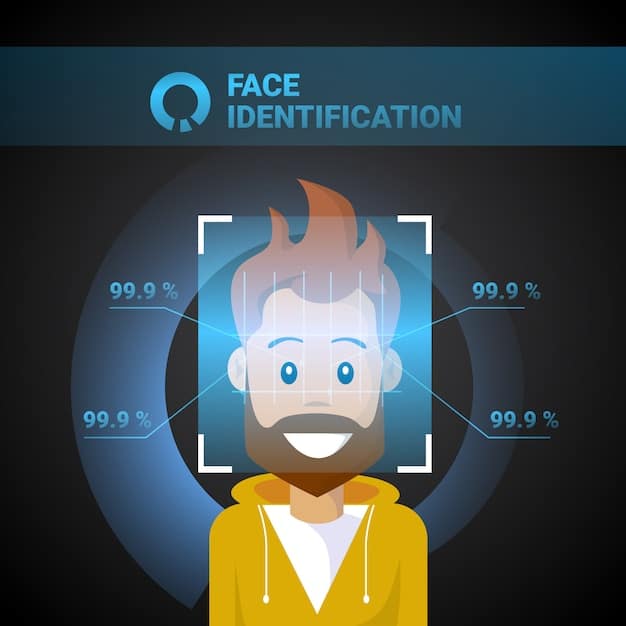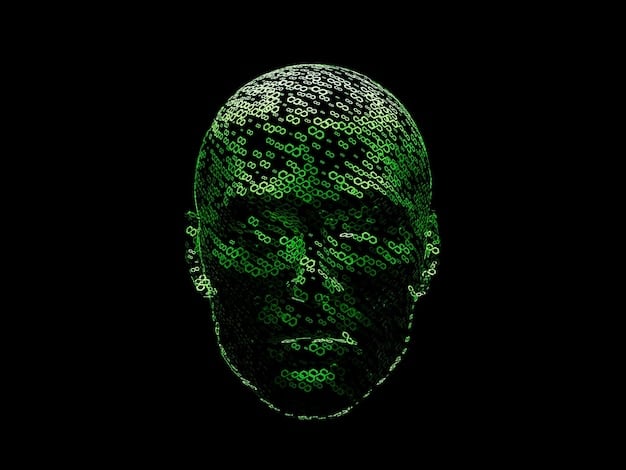Facial Recognition: Opt Out and Protect Your Biometric Data

Facial recognition technology raises significant privacy concerns, making it crucial to understand how to opt out and protect your biometric data by adjusting privacy settings, using privacy-enhancing technologies, and advocating for stronger regulations.
Facial recognition technology is increasingly prevalent in our daily lives, from unlocking our smartphones to enhancing security systems. However, this convenience comes with significant privacy implications. It’s vital to understand how to opt out and protect your biometric data in an era where your face can be scanned and analyzed without your knowledge.
Understanding the Rise of Facial Recognition Technology
Facial recognition technology has rapidly advanced, becoming integrated into various aspects of modern life. It’s used in security, marketing, and even everyday conveniences. But what exactly is facial recognition, and why is it so pervasive?
The increasing use of facial recognition technology presents both opportunities and risks. Understanding its capabilities and limitations is the first step in taking control of your privacy.
What is Facial Recognition?
Facial recognition is a technology that identifies or verifies a person from a digital image or video frame. It works by mapping facial features from a photograph or video, then compares this data with faces stored in a database.
Why is it Everywhere?
The ubiquity of facial recognition is driven by several factors, including advancements in artificial intelligence, increased availability of data, and its perceived efficiency in various applications. From retail to law enforcement, its applications are widespread.

Here are some of the common applications of facial recognition:
- Security Systems: Used to grant access to buildings, devices, and secure areas, enhancing security measures.
- Retail: Employed for customer identification, personalized marketing, and loss prevention in stores.
- Law Enforcement: Utilized for identifying suspects, tracking individuals, and enhancing public safety.
- Social Media: Used to tag individuals in photos and videos automatically, enhancing user experience.
Facial recognition technology is becoming increasingly common, making it essential to understand its impact on privacy and security. The next step is to explore the risks associated with its widespread use.
Privacy Risks Associated with Facial Recognition
While facial recognition technology offers numerous benefits, it also poses significant privacy risks. Understanding these risks is crucial for protecting your biometric data and opting out where possible. How can facial recognition compromise your privacy?
The privacy risks associated with facial recognition technology are multifaceted and can have far-reaching consequences. It’s important to be aware of these potential pitfalls to make informed decisions about your personal data.
Data Collection and Storage
One of the primary risks is the collection and storage of your biometric data without your explicit consent. Many companies and organizations collect facial data through cameras and other surveillance systems, storing this information in databases.
Misidentification and Bias
Facial recognition systems are not foolproof and can lead to misidentification, particularly for individuals from marginalized communities. Biases in algorithms can result in incorrect matches, leading to unjust outcomes.
- Surveillance: Continuous monitoring of individuals without their knowledge or consent, infringing on personal privacy.
- Data Breaches: Stored biometric data can be vulnerable to hacking and data breaches, exposing sensitive information.
- Lack of Transparency: Many organizations use facial recognition technology without disclosing it to the public, making it difficult to understand how your data is being used.
- Erosion of Anonymity: The ability to identify individuals in public spaces erodes anonymity, potentially chilling free speech and assembly.

The risks associated with facial recognition are significant and underscore the importance of taking steps to protect your privacy. The next section will delve into strategies for opting out of facial recognition systems.
Strategies to Opt Out of Facial Recognition Systems
Protecting your biometric data involves taking proactive steps to opt out of facial recognition systems. While completely avoiding facial recognition may not be possible, there are several strategies you can employ to minimize your exposure. What steps can you take to regain control over your facial data?
Opting out of facial recognition systems requires a combination of technical solutions, policy advocacy, and behavioral adjustments. By taking a multi-faceted approach, you can significantly reduce your vulnerability to privacy intrusions.
Adjusting Privacy Settings
Many social media platforms and apps use facial recognition to identify you in photos and videos. Adjusting your privacy settings can limit the collection and use of your facial data.
Using Privacy-Enhancing Technologies
Privacy-enhancing technologies, such as VPNs and privacy browsers, can help mask your online identity and reduce the risk of facial recognition.
Here are some practical steps you can take to opt out:
- Review Social Media Settings: Disable facial recognition tagging features on platforms like Facebook and Instagram.
- Use VPNs: Mask your IP address to prevent tracking and profiling.
- Opt-Out Requests: Send formal requests to companies and organizations asking them to delete your biometric data.
- Use Privacy Browsers: Employ browsers like Brave or DuckDuckGo that block trackers and enhance privacy.
By implementing these strategies, you can take control of your facial data and mitigate the risks associated with facial recognition technology. The next section explores legal and regulatory aspects.
Legal and Regulatory Landscape of Facial Recognition
The legal and regulatory landscape surrounding facial recognition is constantly evolving, with different jurisdictions taking varying approaches to regulate its use. Understanding these legal frameworks is essential for advocating for stronger privacy protections. What are the current laws and regulations governing facial recognition?
The patchwork of laws and regulations governing facial recognition reflects the complex interplay between innovation, public safety, and privacy rights. Staying informed about these developments is crucial for advocating for responsible use of this technology.
Current Laws and Regulations
Several states and countries have enacted laws to regulate the use of facial recognition technology. These laws often focus on obtaining consent, limiting data collection, and ensuring transparency.
Advocating for Stronger Protections
Advocating for stronger legal protections is crucial for ensuring responsible use of facial recognition. This includes supporting legislation that mandates transparency, accountability, and individual rights.
| Key Point | Brief Description |
|---|---|
| 🔒 Adjust Privacy Settings | Limit data collection by reviewing and adjusting privacy settings on social media and apps. |
| 🛡️ Use VPNs | Mask your IP address to reduce tracking and enhance online privacy. |
| 📝 Opt-Out Requests | Submit requests to companies to delete your biometric data from their databases. |
| 🏛️ Support Legislation | Advocate for laws that protect biometric data and regulate facial recognition use. |
Frequently Asked Questions
▼
Biometric data refers to unique physical or behavioral characteristics that can be used to identify an individual. In the context of facial recognition, it includes facial features like the distance between eyes, shape of the nose, and contour of the face.
▼
Many companies are not transparent about their use of facial recognition. Look for privacy policies that mention biometric data collection or facial recognition. Also, be aware of surveillance cameras in retail stores and public spaces.
▼
It depends on the laws in your jurisdiction. Some states have biometric privacy laws that allow individuals to sue companies for collecting and using their biometric data without consent. Consult with a legal professional for advice.
▼
Several VPNs are known for their strong privacy features, including NordVPN, ExpressVPN, and ProtonVPN. Look for VPNs that have a strict no-logs policy and use strong encryption to protect your data.
▼
Stay informed by following privacy advocacy groups, reading tech news, and consulting legal experts. Several organizations are dedicated to monitoring and reporting on developments in biometric privacy laws and facial recognition technology.
Conclusion
Taking control of your biometric data is essential in an era dominated by facial recognition technology. By understanding the risks, implementing opt-out strategies, and advocating for stronger legal protections, you can safeguard your privacy and make informed decisions about your personal data.





